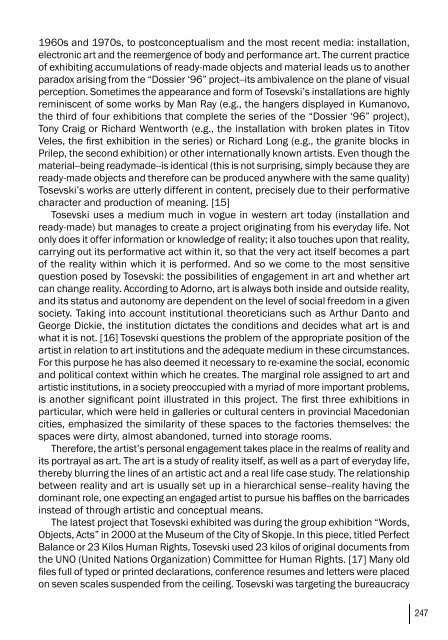art-e-conomy _ reader - marko stamenkovic
art-e-conomy _ reader - marko stamenkovic
art-e-conomy _ reader - marko stamenkovic
Create successful ePaper yourself
Turn your PDF publications into a flip-book with our unique Google optimized e-Paper software.
1960s and 1970s, to postconceptualism and the most recent media: installation,<br />
electronic <strong>art</strong> and the reemergence of body and performance <strong>art</strong>. The current practice<br />
of exhibiting accumulations of ready-made objects and material leads us to another<br />
paradox arising from the “Dossier ‘96” project--its ambivalence on the plane of visual<br />
perception. Sometimes the appearance and form of Tosevski’s installations are highly<br />
reminiscent of some works by Man Ray (e.g., the hangers displayed in Kumanovo,<br />
the third of four exhibitions that complete the series of the “Dossier ‘96” project),<br />
Tony Craig or Richard Wentworth (e.g., the installation with broken plates in Titov<br />
Veles, the first exhibition in the series) or Richard Long (e.g., the granite blocks in<br />
Prilep, the second exhibition) or other internationally known <strong>art</strong>ists. Even though the<br />
material--being readymade--is identical (this is not surprising, simply because they are<br />
ready-made objects and therefore can be produced anywhere with the same quality)<br />
Tosevski’s works are utterly different in content, precisely due to their performative<br />
character and production of meaning. [15]<br />
Tosevski uses a medium much in vogue in western <strong>art</strong> today (installation and<br />
ready-made) but manages to create a project originating from his everyday life. Not<br />
only does it offer information or knowledge of reality; it also touches upon that reality,<br />
carrying out its performative act within it, so that the very act itself becomes a p<strong>art</strong><br />
of the reality within which it is performed. And so we come to the most sensitive<br />
question posed by Tosevski: the possibilities of engagement in <strong>art</strong> and whether <strong>art</strong><br />
can change reality. According to Adorno, <strong>art</strong> is always both inside and outside reality,<br />
and its status and autonomy are dependent on the level of social freedom in a given<br />
society. Taking into account institutional theoreticians such as Arthur Danto and<br />
George Dickie, the institution dictates the conditions and decides what <strong>art</strong> is and<br />
what it is not. [16] Tosevski questions the problem of the appropriate position of the<br />
<strong>art</strong>ist in relation to <strong>art</strong> institutions and the adequate medium in these circumstances.<br />
For this purpose he has also deemed it necessary to re-examine the social, economic<br />
and political context within which he creates. The marginal role assigned to <strong>art</strong> and<br />
<strong>art</strong>istic institutions, in a society preoccupied with a myriad of more important problems,<br />
is another significant point illustrated in this project. The first three exhibitions in<br />
p<strong>art</strong>icular, which were held in galleries or cultural centers in provincial Macedonian<br />
cities, emphasized the similarity of these spaces to the factories themselves: the<br />
spaces were dirty, almost abandoned, turned into storage rooms.<br />
Therefore, the <strong>art</strong>ist’s personal engagement takes place in the realms of reality and<br />
its portrayal as <strong>art</strong>. The <strong>art</strong> is a study of reality itself, as well as a p<strong>art</strong> of everyday life,<br />
thereby blurring the lines of an <strong>art</strong>istic act and a real life case study. The relationship<br />
between reality and <strong>art</strong> is usually set up in a hierarchical sense--reality having the<br />
dominant role, one expecting an engaged <strong>art</strong>ist to pursue his baffles on the barricades<br />
instead of through <strong>art</strong>istic and conceptual means.<br />
The latest project that Tosevski exhibited was during the group exhibition “Words,<br />
Objects, Acts” in 2000 at the Museum of the City of Skopje. In this piece, titled Perfect<br />
Balance or 23 Kilos Human Rights, Tosevski used 23 kilos of original documents from<br />
the UNO (United Nations Organization) Committee for Human Rights. [17] Many old<br />
files full of typed or printed declarations, conference resumes and letters were placed<br />
on seven scales suspended from the ceiling. Tosevski was targeting the bureaucracy<br />
247


